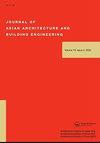突发公共卫生事件中城市空间资源配置的反思:广州酒店舒适检疫环境评估
IF 1.6
4区 工程技术
0 ARCHITECTURE
Journal of Asian Architecture and Building Engineering
Pub Date : 2024-04-10
DOI:10.1080/13467581.2024.2332755
引用次数: 0
摘要
为应对公共卫生突发事件,许多地区都征用了日常旅行酒店作为临时隔离场所。然而,以往很少有研究对这一政策进行探讨,并对其产生的影响进行反思。本文章由计算机程序翻译,如有差异,请以英文原文为准。
Rethinking urban spatial resource allocation during public health emergencies: assessing comfortable quarantine environment in Guangzhou Hotels
In response to public health emergencies, many regions have requisitioned daily travel hotels as temporary quarantine places. However, few previous studies examine this policy and reflect on the ra...
求助全文
通过发布文献求助,成功后即可免费获取论文全文。
去求助
来源期刊
CiteScore
2.20
自引率
15.40%
发文量
127
审稿时长
9 months
期刊介绍:
Journal of Asian Architecture and Building Engineering is a refereed international Open Access journal, serving researchers in academic and research organizations and all practitioners in the building sector. The journal is jointly-edited by the Architectural Institute of Japan (AIJ), the Architectural Institute of Korea (AIK), and the Architectural Society of China (ASC) and published bi-monthly.
Asian academics and professionals have made efforts to find solutions to the themes derived from natural, geographical, socio-economical and cultural conditions in Asia. Their achievements have contributed to the evolution of research in the field of architecture and building engineering. For instance, achievements in structural engineering have contributed to the world by developing technology to assure safety of buildings in earthquake-prone areas.
Asia has the largest share of the world''s population with high densities in urban areas. It is a growing and the most energetic region in terms of building activities, which produces valuable empirical knowledge and lessons to architects and building engineers in Asia. It is quite significant to contribute to global architecture and building engineering by presenting the knowledge and lessons beyond linguistic barriers.
By publishing the journal in English, it is expected that Asian wisdom and experience will be disseminated to the world. In the countries where these institutions are based, building professions can enjoy the collaborative and holistic approach because the three institutions distinctively possess the whole range of expertise relating to architecture and building engineering.

 求助内容:
求助内容: 应助结果提醒方式:
应助结果提醒方式:


